Good Things Come in...Polymer Packages?
This article is based on a recent paper, A simple, cost-effective emitter for controlled release of fish pheromones: Development, testing, and application to management of the invasive sea lamprey, in PLOS ONE, and is available at: http://journals.plos.org/plosone/article?id=10.1371/journal.pone.0197569
Adult sea lamprey are trapped while moving upstream to find suitable spawning habitat. Video: GLFC
Most people know the Great Lakes Fishery Commission uses selective lampricides and barriers as the primary methods to keep the destructive sea lamprey at bay. Perhaps less known is another frontier of sea lamprey control that could potentially augment the current control program: the use of pheromones and other odors (also known as "semiochemicals") to gain information about resources and threats—that can influence sea lamprey behavior. Once in the field, the key to successful use of pheromones will be how easily and cost-efficiently the chemicals can be disbursed. That may sound mundane, but actually getting the pheromones into a body of water, at exactly the concentration needed to change sea lamprey behavior, will make or break the success of this new control technique. Recent research, conducted by scientists at Seton Hall University and Michigan State University, in the use of polymers as a pheromone delivery agent, might just be the solution the Commission has been looking for.
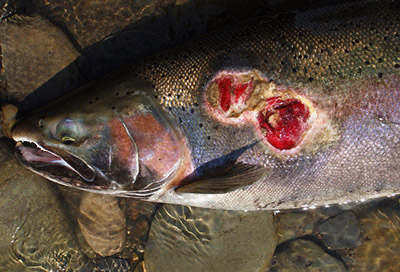
Sea lamprey attach to fish and feed off their blood and body fluids. Only one is seven fish attacked by a sea lamprey will survive. Photo: USFWS
After invading the Great Lakes in the early 20th century, sea lampreys, which latch on to host fish and feed on their blood and body fluids, decimated the fishery by the late 1940s. Beginning in the mid-1950s, the Great Lakes Fishery Commission and its partners, began implementing various control techniques to try to reduce the sea lamprey population and restore the once-thriving fishery. Driven by a robust research program and dedication to innovative solutions, the sea lamprey control program has reduced sea lamprey populations by 90% in most areas of the Great Lakes and is heralded as the most successful aquatic vertebrate invasive species control
program in the world.
Lampricides—piscicides that selectively target sea lamprey larvae—and barriers that prevent sea lamprey infestations are the mainstay of the sea lamprey control program. The Commission also believes an effective pest control program must be integrated, meaning it should use several techniques to attack the problem from many different angles. The sea lamprey's life cycle, similar to salmon, is based on periods of migration; larval lampreys live as filter feeders in streams for up to ten years, undergo a metamorphosis and migrate out to the open lake to feed on fish, and then migrate back to stream or tributary to spawn. These periods of migration have been the focus of research to develop future control methods.
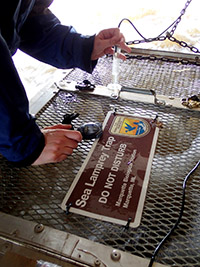
For more than twenty years, the Great Lakes Fishery Commission, with recent funding from the Great Lakes Restoration Initiative, has prioritized research on sea lamprey pheromones and odors with the hope they could be used to improve control. One component of the male mating pheromone, 3-keto-Petromyzonol sulfate (3kPZS) which draws spawning females to nesting sites, was registered by the Environmental Protection Agency as the first-ever biopesticide pheromone for a vertebrate species. Overall, odors such as mating pheromones, alarm signals, migratory cues, and antagonists all have the potential to improve sea lamprey control through the manipulation of sea lamprey behavior.
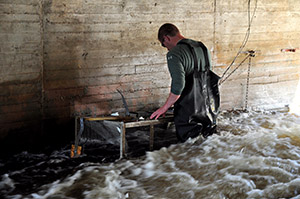
Large-scale field trials have demonstrated that pheromone baits can increase trapping efficiencies by up to 53%. Photos: A. Miehls, GLFC
While research evaluating the use of mating pheromones was ongoing, complementary research to determine the best way to release and disperse the pheromone has been underway. Dr. Michael Wagner, an associate professor at Michigan State University, summarized the challenge the pheromone research team faced: "Sea lampreys have been found in more than 500 Great Lakes tributaries, all which vary in terms of size, complexity, and openness of the habitats. Any [odor] deployment technique must be constructed to work in all types of conditions to reliably deliver the proper compounds in the proper ratio, over sustained periods of time. If the deployment is uneven or slipshod, the effectiveness of the application will, of course, be compromised. So, how the odor is deployed is as critical as what is being disbursed."

.jpg)
Administering the sea lamprey mating pheromone, 3kPZS, using a mechanical pump. Photos: N. Johnson, U.S. Geological Survey
Up until now, research studies had relied on mechanical pumps to release the pheromones. While the pumps allow for regulated dispersal, they require an operator to be on site, are prone to clogs and other malfunctions, require electrical power, and are most easily used from a stationary location (e.g. a stream bank). To improve the dispersal, scientists turned to polymers, a broad category of natural or synthetic substances with versatile properties. Scientists investigated whether polymers could be used as a base to hold and then deliver the male mating pheromone into the environment. Think of a cough drop—as the lozenge (like the polymer) breaks down in the mouth, the cough suppressant (like the pheromone) is released. Polymers are ubiquitous in other domains. Pharmaceuticals, fertilizers, perfumes, and even pheromones for other aquatic species (sharks and trout) have all been successfully dispensed into aquatic environments via polymers.
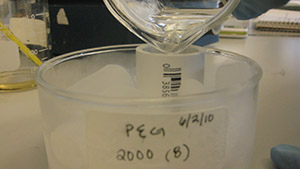
Pouring PEG6000 + 3kPZS into the mold.
Photo: J. Hanson, University of Seton
Dr. James Hanson, a Professor in the Department of Chemistry and Biochemistry at Seton Hall University, whose laboratory developed the polymer emitter for the male sea lamprey pheromone stated: "Our objective was clear: develop a cost-effective, environmentally benign polymer-based emitter for deployment of 3kPZS as a sea lamprey control tool. Because we use the pheromones in natural aquatic ecosystems, any polymer we tested had to be nontoxic and biodegradable."

Ovulated females were significantly more likely to approach the PEG6000 + 3kPZS emitter verses a blank PEG6000 emitter or neither.
The first trick to achieving that objective was to identify a polymer that has a dissolution rate which mediates the release of the active agent, 3kPZS, at the correct rate and concentration. "In this case, the polymer, called PEG6000, is like a Slinky. When it's dry, the coiled Slinky is compressed. When it's put in water, it stretches out and releases the pheromone trapped in between the coils," Wagner explained.
The research team first tested PEG6000 in a laboratory setting to determine if the polymer itself (without 3kPZS added) elicited any behavior response from sea lampreys. Over the course of eight trials, the team concluded that sea lampreys were neither attracted to, nor repelled by, the PEG6000 emitter. This showed the polymer itself would not influence sea lamprey behavior if used in the field.
A sea lamprey moves toward a polymer emitting the mating pheromone 3kPZS. Video: M. Wagner, Michigan State University
Next, the team had to ascertain if PEG6000 with 3kPZS resulted in a behavioral response from mature female sea lampreys in the field. To test this, the team first tested a PEG6000 + 3kPZS against a blank polymer, or just PEG6000. Of the sea lampreys that entered the test area (77% of total subjects), the vast majority (73%) were significantly more attracted to the polymer emitting pheromone (PEG6000 + 3kPZS) than the standalone PEG6000. The team also evaluated behavioral response to 3kPZS released via a mechanical pump verses the PEG6000 polymer, and found no significant difference in preference.
The male mating pheromone 3kPZS is being tested extensively in trapping scenarios across the Great Lakes. Therefore, the ultimate test for the polymer research was to determine if it could be used as a mechanism for control—that is, researchers had to determine if releasing 3kPZS via the polymer PEG6000 would be as effective as the pump-released 3kPZS when used in traps. To test that, traps were placed on the Cheboygan, Manistee, and Muskegon Rivers in Michigan and then were baited with either 3kPZS released via pump or 3kPZS released via the polymer, PEG6000. Each PEG6000 + 3kPZS baited trap captured 50-63% of the total catch, indicating this new mechanism of release is just as effective as the mechanical pump.
The study also showed the polymer would be conducive to field use—an important consideration when evaluating the feasibility of using it for control. Dr. Nick Johnson, a research scientist with the U.S. Geological Survey, led the effort to evaluate the efficacy of the polymer emitter during sea lamprey trapping operations. "We used an automatic pet feeder programmed to release a single emitter based on a nightly schedule," Johnson explained. "Fish and Wildlife Service trap operators who applied 3kPZS with pumps during previous field tests reported the emitters were simpler and faster than pumps, only taking about 1 minute to set-up per day."
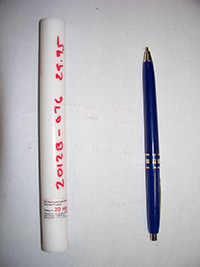
Drs. Wagner and Hanson noticed the polymer emitter was dissolving at different rates during the field trials when water velocities differed—more turbulence prompted the formation of "pits and peaks" on the surface of the polymer, increasing the exposed surface area and leading to a faster dissolution rate. Therefore, as a last objective to this study, the research team assessed whether placing the emitter into a "housing" would regulate the rate of dissolution. "We used a segment of large diameter pipe with a cap attached at one end—without glue to avoid introducing any foreign odors. The pipe was transected 5 cm below the cap with a wooden dowel, to which we attached the emitter," Wagner described. Tests of the housing in a recirculating flume tank showed a more consistent dissolution rate of the polymer despite changes in water velocity.
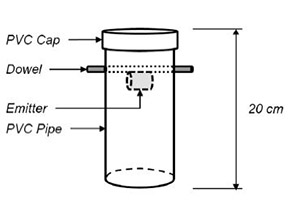
The emitter housing was constructed with 20 cm length of PVC pipe capped on one end. The polymer emitter was attached with a single rubber band to a wooden dowel inserted through drilled holes 5 cm below the cap.
Photos: (L) M. Wagner, Michigan State University and J. Hanson, University of Seton; (R) N. Johnson, U.S. Geological Survey
"This research brings us one big step closer to being able to employ pheromones and does as cost-effective sea lamprey control techniques," said Commissioner Jim McKane, chair of the Great Lakes Fishery Commission. "Over the last 65 years, we have learned just how tenacious and resilient sea lamprey are. Although we have reduced populations by 90%, we will never stop looking for new, and better, ways to control their population and protect the $7 billion dollar Great Lakes fishery and its ecosystem."
Read more Pulse on Science: Project Spotlights
- Sea Lamprey Control Spreads the Distance
- Making the Best of a Bad Situation: Great Lakes Sea Lampreys Reveal the Origins of Vertebrate Traits
- Studying the Fish of Buffalo Reef, Traverse Bay, Lake Superior
- Doing Science is Essential...Communicating Science is Just as Critical (and maybe more FUN!)
- Faithful Fish: Walleye Show High Spawning Site Fidelity in the Great Lakes
- Finding the Sea Lamprey's Kryptonite
- Good Things Come in...Polymer Packages?
- Rambunctious Reproduction Overheard Among Great Lakes' Lake Trout
- Clearer Water Means Less Fish: Understanding How Lower Trophic Level Changes Impact Lake Huron's Fisheries

